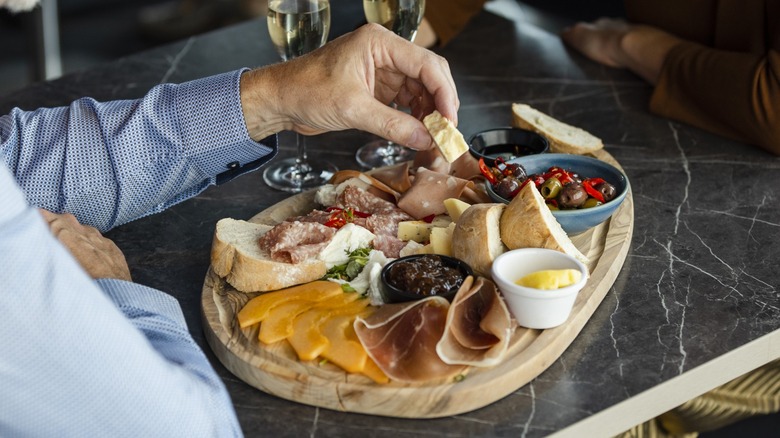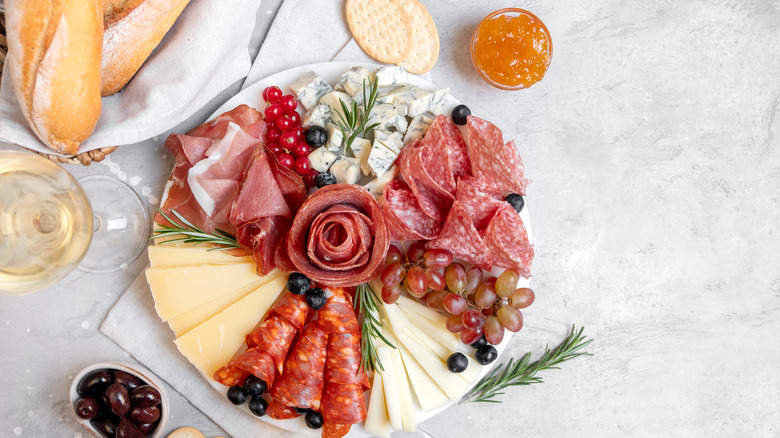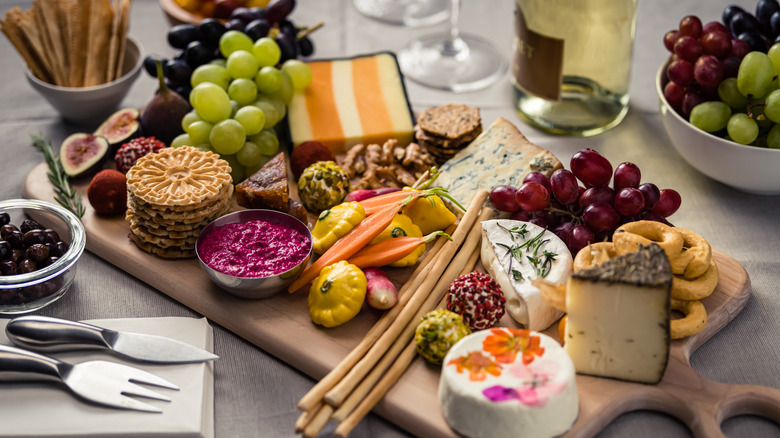The Red Flag To Look Out For When Ordering Charcuterie At A Restaurant
If you're looking to order a charcuterie board at a restaurant, would you know what red flags to look for? If not, you might want to take a tip from Dominick DiBartolomeo, owner of The Cheese Store of Beverly Hills. DiBartolomeo told Chowhound recently, "I really look to see if they are thinking it through and curating the experience for the guest." Basically, generic, unimaginative ingredients lead to subpar boards. Meanwhile, thoughtfully curated boards that take into account seasonality, access to local artisanal products, and the balance of textures and taste tend to be worth the money.
Your search for red flags begins before you even sit down. Most restaurants that curate any part of the dining experience usually advertise their specially sourced ingredients. For example, a gastropub will take pains to let you know about a new, local craft beer they have on tap. The same goes for the charcuterie board. Whether advertised on the menu, on the special boards at the front of the restaurant, or even possibly on the eatery's website, you should be able to see some fanfare for any artisan cheeses and meats the restaurant is proud to serve.
By the same token, don't disregard what you might learn from chatting with the restaurant's waitstaff. If they're trained well, they'll offer deeper insight into what goes into the eatery's food prep. If you're getting a lot of shoulder shrugs or vague answers to your inquiries, you may be looking at a red flag. The amount of thought and care that has gone into these elements will tell you a lot about how curated your experience will be.
How to spot a thoughtfully curated charcuterie board
If you've seen no major red flags after your preliminary investigation, it's time to take a deeper dive into the specifics of what you should see on the menu or hear from your server. These should include words and phrases like "made-in-house," "artisanal selection," "regional specialties," "seasonal offerings," and, in some circumstances, "vegan" or "keto."
If you see these types of offerings on the menu, take things further by talking to your server about them. Many eateries offer tastings for the servers when they're introducing new items. This allows the waitstaff to speak knowledgeably with restaurant guests about how the board looks and tastes. Ditto for how it's prepared, how often the shipments of the charcuterie supplies come in, and where it's sourced from. The server should also know when the board was assembled. At the very least, it should have come together that day.
Finally, there's one true way to ensure that you get a board that's been curated just for you: Ask if the restaurant offers made-to-order boards. If it does, you're certain to get a board that's custom-designed to fit your taste buds instead of a charcuterie board filled with boring ingredients. Having an experience that's counter to any of these recommendations suggests that you should pay closer attention. A red flag might just be waiting to sneak up the flagpole.
Look for charcuterie items that play off one another
There's more to a decent restaurant charcuterie board experience than it being made-to-order. The best charcuterie boards boast a considered approach to the contrasting flavors and textures that make up the board. For instance, soft and sweet creamy cheese should be served with crusty artisan bread and spicy hard salami slices should be balanced by fresh, juicy fruit. These boards should also feature the five flavors: umami, sweet, sour, salty, and bitter. Ideally, the best boards are studies on contrasts, while at the same time, offering a cornucopia of regional and specialty foodstuffs. If your board has most or all of these elements, you're getting well-curated charcuterie.
For example, if you're at a steakhouse, a charcuterie board should feature cuts of Wagyu steak, house-made jerky, or another kind of smoked beef paired with the restaurant's special sauce. Meanwhile, a restaurant in California should offer craft jellies that feature local produce, like Black Mission fig or Elberta Peach. The same can be said of restaurants in the Midwest that serve artisan cheeses on their boards. You should get a serving of grass gruyere from a world champion cheese maker in Wisconsin, not a generic sampling of "aged cheddar" from some undisclosed cheesemaker. While the specifics may change, the spirit of what's being suggested here does not. Your senses should never get bored when you're diving into a curated charcuterie board.


